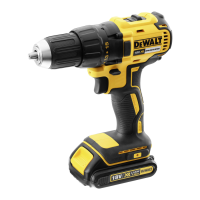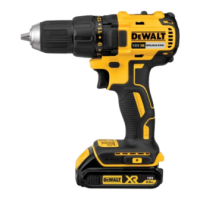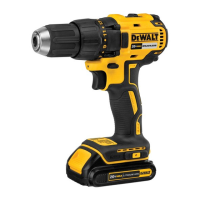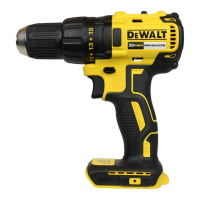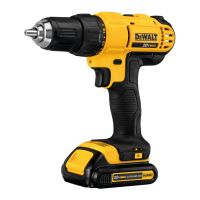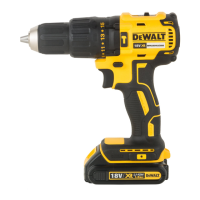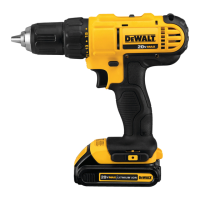10
ENGLISH
1. To select speed 1 (high torque setting), turn the tool off and
permit it to stop. Slide the gear shifter
4
forward (towards
the chuck).
2. To select speed 2 (low torque setting), turn the tool off and
permit it to stop. Slide the gear shifter back (away from
thechuck).
NOTE: Do not change gears when the tool is running. Always
allow the drill to come to a complete stop before changing
gears. If you are having trouble changing gears, make sure that
the dual range gear shifter is either completely pushed forward
or completely pushedback.
Worklight (Fig.A)
There is a worklight
5
located just above the trigger switch
1
.
The worklight is activated when the trigger switch is depressed.
When the trigger is released, the worklight will stay illuminated
for up to 20seconds.
NOTE: The worklight is for lighting the immediate work surface
and is not intended to be used as aflashlight.
Keyless Single Sleeve Chuck (Fig.G–I)
WARNING: Do not attempt to tighten drill bits (or
any other accessory) by gripping the front part of the
chuck and turning the tool on. Damage to the chuck
and personal injury may result. Always lock off trigger
switch and disconnect tool from power source when
changingacces sories.
WARNING: Always ensure the bit is secure before starting
the tool. A loose bit may eject from tool causing possible
personalinjury.
Your tool features a keyless chuck
6
with one rotating sleeve for
one-handed operation of the chuck. To insert a drill bit or other
accessory, follow thesesteps.
1. Turn tool off and disconnect tool from powersource.
2. Grasp the black sleeve of the chuck with one hand
and use the other hand to secure the tool. Rotate the
sleeve counterclockwise far enough to accept the
desiredaccessory.
3. Insert the accessory about 19 mm into the chuck and
tighten securely by rotating the chuck sleeve clockwise with
one hand while holding the tool with the other. Your tool is
equipped with an automatic spindle lock mechanism. This
allows you to open and close the chuck with onehand.
Be sure to tighten chuck with one hand on the chuck sleeve and
one hand holding the tool for maximumtightness.
To release the accessory, repeat steps 1 and 2above.
OPERATION
Instructions for Use
WARNING: Always observe the safety instructions and
applicableregulations.
WARNING: To reduce the risk of serious personal
injury, turn tool off and disconnect battery pack
before making any adjustments or removing/
installing attachments/accessories or when making
repairs. An accidental start-up can causeinjury.
Proper Hand Position (Fig. C)
WARNING: To reduce the risk of serious personal injury,
ALWAYS use proper hand position asshown.
WARNING: To reduce the risk of serious personal
injury, ALWAYS hold securely in anticipation of a
suddenreaction.
Proper hand position requires one hand on the main handle
9
and one hand on the batterypack.
Screwdriver Operation (Fig.D)
1. Select the desired speed/torque range using the dual
range gear selector to match the speed and torque of the
plannedoperation.
2. Turn the torque adjustment collar
3
to the desired position.
Lower numbers indicate lower torque settings; higher
numbers indicate higher torquesettings.
3. Insert the desired fastener accessory into the chuck as you
would any drillbit.
4. Make some practice runs in scrap or on unseen areas to
determine the proper position of the clutchcollar.
5. Always start with lower torque settings, then advance to
higher torque settings to avoid damage to the workpiece
orfastener.
Drill Operation (Fig.E)
WARNING: To reduce the risk of serious personal injury,
turn tool off and disconnect tool from power source
before making any adjustments or removing/installing
attachments oraccessories.
WARNING: TO REDUCE THE RISK OF PERSONAL
INJURY, ALWAYS ensure workpiece is anchored or
clamped firmly. If drilling thin material, use a wood “back-
up” block to prevent damage to thematerial.
1. Turn the collar
3
to the drillsymbol.
2. Select the desired speed/torque range using the gear shifter
to match the speed and torque to the plannedoperation.
3. For Wood, use twist bits, spade bits, power auger bits or
hole saws. For Metal, use high-speed steel twist drill bits
or hole saws. Use a cutting lubricant when drilling metals.
The exceptions are cast iron and brass which should be
drilleddry.
4. Always apply pressure in a straight line with the bit. Use
enough pressure to keep drill biting, but do not push hard
enough to stall the motor or deflect thebit.
5. Hold tool firmly with both hands to control the twisting
action of the drill. If model is not equipped with side handle,
grip drill with one hand on the handle and one hand on the
batterypack.
CAUTION: Drill may stall if overloaded causing a sudden
twist. Always expect the stall. Grip the drill firmly to control
the twisting action and avoidinjury.
6. IF DRILL STALLS, it is usually because it is being overloaded
or improperly used. RELEASE TRIGGER IMMEDIATELY,
